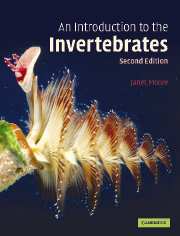Book contents
- Frontmatter
- Contents
- List of boxes
- Preface
- Acknowledgements
- Illustration acknowledgements
- Chapter 1 The process of evolution: natural selection
- Chapter 2 The pattern of evolution: methods of investigation
- Chapter 3 Porifera
- Chapter 4 Cnidaria
- Chapter 5 On being a worm
- Chapter 6 Platyhelminthes and Acoelomorpha
- Chapter 7 Nemertea
- Chapter 8 Nematoda
- Chapter 9 Annelida
- Chapter 10 Mollusca: general and Gastropoda
- Chapter 11 Mollusca: Bivalvia and Cephalopoda
- Chapter 12 Arthropoda: general
- Chapter 13 Crustacea
- Chapter 14 Chelicerata and Myriapoda
- Chapter 15 Insecta
- Chapter 16 Animals with lophophores
- Chapter 17 Echinodermata
- Chapter 18 Invertebrate Chordata and Hemichordata
- Chapter 19 Development
- Chapter 20 Invertebrate evolutionary history
- Further reading
- Glossary
- Index
Chapter 18 - Invertebrate Chordata and Hemichordata
Published online by Cambridge University Press: 05 September 2012
- Frontmatter
- Contents
- List of boxes
- Preface
- Acknowledgements
- Illustration acknowledgements
- Chapter 1 The process of evolution: natural selection
- Chapter 2 The pattern of evolution: methods of investigation
- Chapter 3 Porifera
- Chapter 4 Cnidaria
- Chapter 5 On being a worm
- Chapter 6 Platyhelminthes and Acoelomorpha
- Chapter 7 Nemertea
- Chapter 8 Nematoda
- Chapter 9 Annelida
- Chapter 10 Mollusca: general and Gastropoda
- Chapter 11 Mollusca: Bivalvia and Cephalopoda
- Chapter 12 Arthropoda: general
- Chapter 13 Crustacea
- Chapter 14 Chelicerata and Myriapoda
- Chapter 15 Insecta
- Chapter 16 Animals with lophophores
- Chapter 17 Echinodermata
- Chapter 18 Invertebrate Chordata and Hemichordata
- Chapter 19 Development
- Chapter 20 Invertebrate evolutionary history
- Further reading
- Glossary
- Index
Summary
The phylum Chordata consists mainly of the class Vertebrata (animals with backbones, i.e. the fish, amphibians, reptiles, birds and mammals, including ourselves). There are, however, some smaller groups of animals that do not have backbones but possess the distinctive chordate characters. All are marine, and like the echinoderms they are deuterostomes. These animals are interesting because they demonstrate other varieties of invertebrate life and because they provide information about deuterostome relationships and the origin of vertebrates.
Hemichordates are not chordates. They were unfortunately named before their structure was fully understood and subjected to molecular investigation. They are now recognised as a separate phylum among the deuterostomes; as will be explained, they are closer to echinoderms than to chordates.
CHORDATA
What are the chordate characters?
Figure 18.1 shows the distinctive characters: the notochord, the hollow dorsal nerve cord, the pharyngeal gill slits and the post-anal tail. All these characters are related to swimming by lateral undulations of a body like a tadpole or a fish.
The notochord
The notochord gives the phylum its name (avoid verbal confusion with ‘nerve cord’). It is a dorsal stiffening rod running from near the anterior end to the posterior tip of the body. It is made of close-fitting cells with hydrostatic pressure due to intracellular vacuoles, enclosed in a fibrous sheath; it arises from the roof of the embryonic gut.
- Type
- Chapter
- Information
- An Introduction to the Invertebrates , pp. 236 - 246Publisher: Cambridge University PressPrint publication year: 2006



